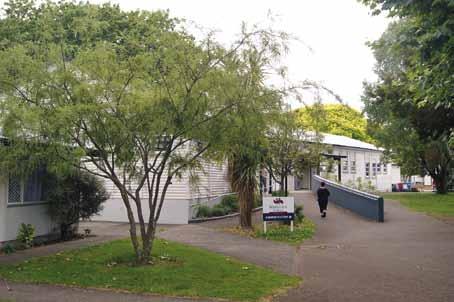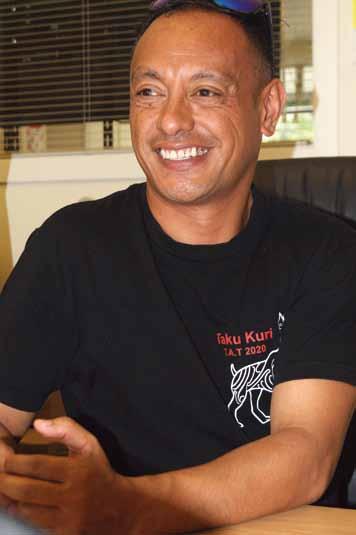
8 minute read
whitiora school’s succEss story


Liz hawes Editor
I N r E c ENT DE ca DES , housing has become a symbol of inequity in Aotearoa New Zealand. It clearly signifies the haves and the have nots. So entrenched are the inequities that stories of families living in garages, caravans, tents, cars and vans no longer make headlines.
Governments of all shades have weathered blame for housing issues. Some for selling off state houses, others for not building enough. Market rents were introduced by one Government then accommodation supplements by another. Couple this with a decade of high immigration (from 2008) with no action to address infrastructure or build more houses and the result is an overheated housing market, insufficient housing stock and
Te Haumoana Biddle and his staff know well the desperation of many of their children’s circumstances. Although not all children live in emergency housing, a significant number do. The transient nature of the school roll makes for difficult planning.
I visit the school just days before the term finishes for the year and am ushered into a room where the floor is stacked high with bulging ‘Pak n Save’ carry bags.
‘The wellbeing of our children and their families is our number one priority,’ says Te Haumoana emphatically, ‘and we can’t do it alone.’
The school has generous partners, including the nearby Pak n Save supermarket who provided the bags filled with staple higher rents for all. As the gap between the advantaged and disadvantaged grows, so do the housing woes.
We don’t just have a growth in the numbers of those without a proper roof over their head, we now have a crisis. The rhetoric has shifted from ‘social housing’ needs to ‘emergency housing’. The latest solution is for homeless families to be deposited in blocks of motels, subsidized by the Government.
Rotorua’s Fenton Street, once the golden mile of motel accommodation for visitors to the tourist city, is now the notso-golden mile of ‘emergency housing’, with all the negative headlines that attracts. Ulster Street in the city of Hamilton is a replica of the Rotorua model and there are many more scattered across the motu.
Life for those in emergency housing is desperate. No one chooses to raise their family in a motel and share their distressing lives with equally despairing neighbours. These victims of society’s inequities have either tried everything to lift themselves out of destitution and failed, or acquiesced to helplessness. Gang influences, mental health issues, trauma, and anxieties flourish like a virus in these communities, sometimes resulting in crime, drug addictions and violence.
Whitiora Primary School sits in the middle of the new motel emergency housing area of Kirikiriroa. The Principal, foods, and a few extra goodies, to help the families get through Christmas and the summer school break. Any spare room is topped up with various articles of clothing and footwear provided by KidsCan.
‘There is one bag for every family in our school,’ says Te Haumoana. ‘We know holidays can be tough for our families because when school is closed, the children don’t have their usual school breakfast and lunch,’ he said.
He and his staff are grateful for the Government’s policy to provide lunch for low decile schools like his own. ‘We would be feeding our kids anyway,’ he said, ‘but having these meals provided means we have the food money to spend on other supports.’
The school can’t address all the social ills, but they do everything possible to provide physical and emotional nourishment and a sense of security, safety and consistency whilst the children are at school.
‘Our children all know that every staff member here cares about them and will keep them safe,’ says Te Haumoana.
The Whitiora School curriculum follows Te Whare Tapa Whā, a holistic model of health and wellbeing. It was originally developed for the healthcare sector and was the brainchild of Māori health expert, Professor Mason Durie. It comprises four dimensions that influence teaching in a positive way.
The four dimensions are:
Taha wairua – the spiritual domain or wellbeing of the learner
Taha tinana – the physical domain or well-being of the learner
Taha whānau – the family or social well-being of the learner

Taha hinengaro – the mental domain or well-being of the learner
Thinking about these four dimensions as the four sides of a wharenui, it becomes clear that if any one side is weak, the whare is in danger of falling over. For learning to occur all four dimensions must be strong. This shifts the Kaiako (teacher’s) thinking to include factors beyond the content to be taught. The learner (ākonga) is at the centre, so all four dimensions are equally considered. It is a framework for teaching and learning. It guides the school in shaping their learning programmes and hauora (well-being) plan. It ensures, for example, that all ākonga have eaten before learning starts for the day, and that they all have lunch to sustain them through the afternoon’s learning.
Whitiora School has a higher than usual number of young people suffering trauma, anxiety and stress, due to their living conditions and the uncertainties in their everyday lives. Principal, Te Haumoana Biddle, is acutely aware of the high needs of some of his ākonga and invests accordingly.
‘We are fortunate to have a very effective support team, Te Puumanawa, at our school, comprising a full-time guidance counsellor, a full-time learning support coordinator (LSC), a full-time social worker, who also works with our families, and a member of our Senior Leadership Team (SLT), leads this support team full-time,’ he said. ‘We also have an excellent team of learning assistants and teacher aides.’
Outside of the Puumanawa team are further support agencies such as the Breakfast Club (a church group), the District Health Board and the Pacific Island Centre for Health, to name a few. I met Assistant Principal, Kate, who leads Te Puumanawa. ‘Priority is to first make school a safe and nurturing place to be,’ said Kate. ‘I am a trauma-informed teacher, trained by a psychologist and my job is to respond to behavioural issues in the school and work with our school counsellor to deliver my skills back to the staff,’ she said.
‘We have well-being plans for our ākonga which identify their strengths and indicate where intervention might be needed,’ she said.
Akonga learn how to recognize when they need help. They learn about the ‘red’ and ‘green’ brains. The red brain relates to feelings of anger or violence while the green brain is the calm brain. Students learn strategies to deal with their red brain feelings, such as withdrawal to a green space to make them feel calm again. Once calm, they can talk through what triggered the anger.
‘Students are encouraged to take responsibility for their actions and to give back,’ said Kate. To illustrate her point she told me the story of a group of young girls caught vaping at school. First, they were educated about the risks of vaping then they created a presentation to show the Puumanawa team, their own class and their whānau, triggering discussions and positive commentary.
‘Relationships are everything,’ said Kate, ‘and the connections ākonga have with their teachers and other students, keeps them coming to school,’ she said.
This excellent work gives life to the school’s ‘heart’ which aspires to produce young people who are honest, engaged, have good attitudes, are risk takers and are thoughtful. These are the values of the school and are clearly communicated at every opportunity.
Hands-on experiences are highly rated at Whitiora School. Ākonga have opportunities to work with clay, which is very soothing, and to create objects which are wood fired and become treasured pottery pieces. They also love to bake and cook and work in the gardens with the help of learning assistants.


‘These are excellent opportunities for ākonga to engage in conversations, to share with each other, communicate, expand their vocabulary and have new experiences,’ said Kate.
Other experiences have included taking whole classes to a restaurant for a meal. ‘Through going to the restaurant for a meal together, ākonga learned many life skills – how to queue in an orderly way, what a smorgasbord is and how it works, how to behave in a restaurant, how to use all the utensils and how to interact with the wait staff,’ she said.
These hands-on experiences are the entry point for formal writing. Ākonga are far more motivated to write about something
Nic Bean 021 278 0098 / nic@sportclub.co.nz Sportcourtcentre.co.nz
Your only New Zealand supplier of the innovative NexxtGrip sport
Sport that creates identity, addresses sustainability head-on, improves performance, and has a 10 year warranty. A floor for everybody in the community. they have done, made or visited.
Role modelling is another important aspect of learning. Not only are the teachers role models but special visitors are invited to the school to provide aspirational models for ākonga. The Governor General, for example opened Whitiora’s new learning space and sportspeople and other high-profile figures are invited to speak with ākonga. These are uplifting experiences giving a sense that life can offer many options.
I had the privilege of sharing lunch with ākonga and talking to them. What I found were groups of engaging, polite, inclusive young people unafraid to meet a stranger like me and curious enough to politely ask how my camera worked. Some of the photos that appear in this article were taken by some of those curious quick learners.
Whitiora has its challenges. The school educates big numbers of young people from some of our most disconnected and disenfranchised families in the country. Yet most of these tamariki are largely indistinguishable from any other group of young people in Aotearoa New Zealand.


There is no doubt that Te Whare Tapa Whā approach to learning has a big part to play, but more than that it is the extraordinary devotion and commitment of the staff to the ākonga and whānau of the school that makes the real difference. If you are a teacher who wants to make a difference, then go visit Whitiora school!
Whitiora is a remarkable success story.
The Challenger 1000 Portable PA system with stand and wireless microphone
For sports, Assembly, Jump Jam and performances.
Best sounding portable PA in New Zealand. Fully featured, top quality and easy to use. Includes a weather cover for outdoor use.
Built-in trolley and powerful rechargeable batteries so you can take it anywhere.
$2749+gst for the wireless PA system
$2749 + gst
Interactive Intelligent Flat Panel TVs
• From 65”–98”
• 4K Ultra-High definition
• Electronic Whiteboard
• Touch control
• Wireless presentations
• Wall mount or on mobile trolley
• Available with camera/ speakers for zoom/ teams, or without
School Hall Audio Visual Revamp
If it is time to revamp the hall AV system please drop us a line.
Large automated electric screens, Projectors with HDMI wall connection, Lighting, Sound systems and wireless microphones . . .
sales@edwardsnz.co.nz edwardsnz.co.nz
• Park Supplies & Playgrounds design and manufacture playgrounds right here in New Zealand and have been doing so for more than 30 years.


• We customise to your specific needs rather than importing componentry from overseas and you have the reassurance that our equipment is robust and made for New Zealand conditions.
Our
• Park Supplies & Playgrounds provide imaginative and fun playground solutions to aid in development, fitness and learning.
• We value input from your staff and students and will involve you in the design process to ensure your playground needs and dreams are realised.







